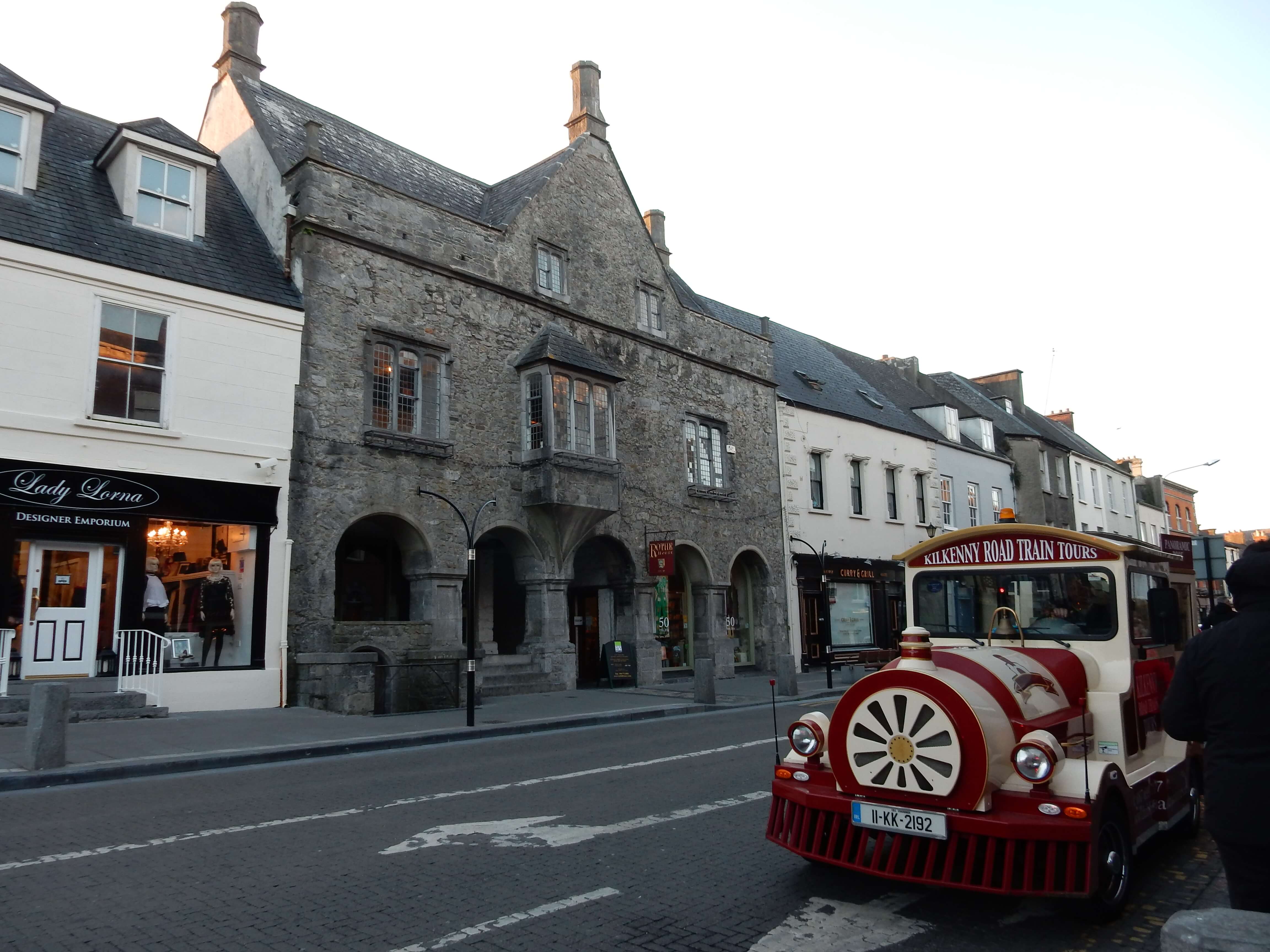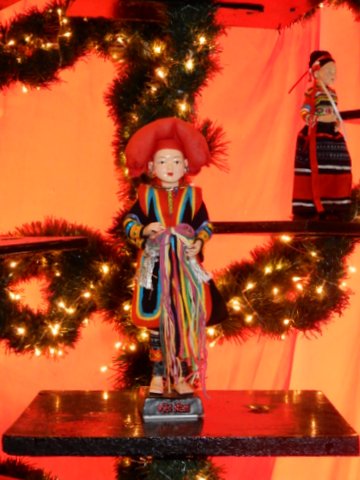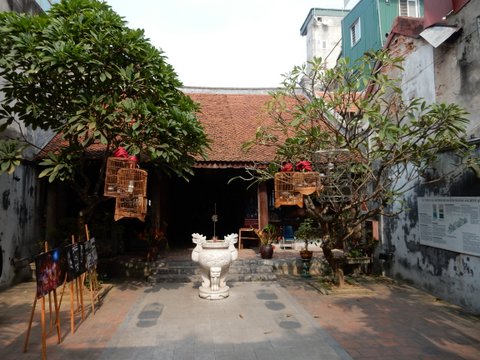By Linda Gasparello
“But real adventures, I reflected, do not happen to people who remain at home: they must be sought abroad.” — James Joyce, “Dubliners”
Ireland is always an adventure.
My husband, Llewellyn King, and I have traveled there frequently since the early 1980s. Our first trip, on which we drove with friends from Dublin to Dingle, gave us some of our most memorable impressions of the country.
Nearly every summer from 1989-2010, we traveled to Ballina, Co. Mayo, in the west of Ireland, to participate in the Humbert Summer School (named after one of Napoleon’s generals, Jean Joseph Amable Humbert), founded by journalist John Cooney for “the study of Ireland and Europe.” It was a Brigadoon-like event, attracting academics, politicians, musicians, writers and many faithful regulars – who Cooney called “Hubertians” — from all over Ireland and abroad.
The school’s sessions took place in many Mayo venues, from Moyne College and Murphy Brothers Bar & Restaurant in Ballina to the Golden Acres pub in Kilalla and Bessie’s Bar in Kilcummin — a beachead on the county’s northern coast, where a French expedition commanded by Gen. Humbert landed on Aug. 22, 1798, in an attempt to assist Irish rebels during the 1798 Rebellion.
During those summers Humbertians did a lot of thinking, heightened by a lot of drinking.
Shortly before the election, Llewellyn and I traveled to Ireland to attend the Association of European Journalists’ (AEJ) annual meeting, held in Kilkenny this year. The association skirts the high cost of holding meetings in Europe’s big cities by holding their annual in small ones, like Maastricht, Netherlands, Burgenland, Austria and Sibiu, Romania.
In addition to its serious purpose, the AEJ annual meeting has much of the fun and good fellowship as did the Humbert School. A few of its members were also Humbert regulars, including our friends David Haworth, who lives in Brussels and writes for The Irish Daily Mail, and Joe Carroll, who covered Washington and the Clinton White House for The Irish Times.
“There’s no friends like the old friends,” Joyce also wrote in “Dubliners.”
Two Celebrations in Dublin
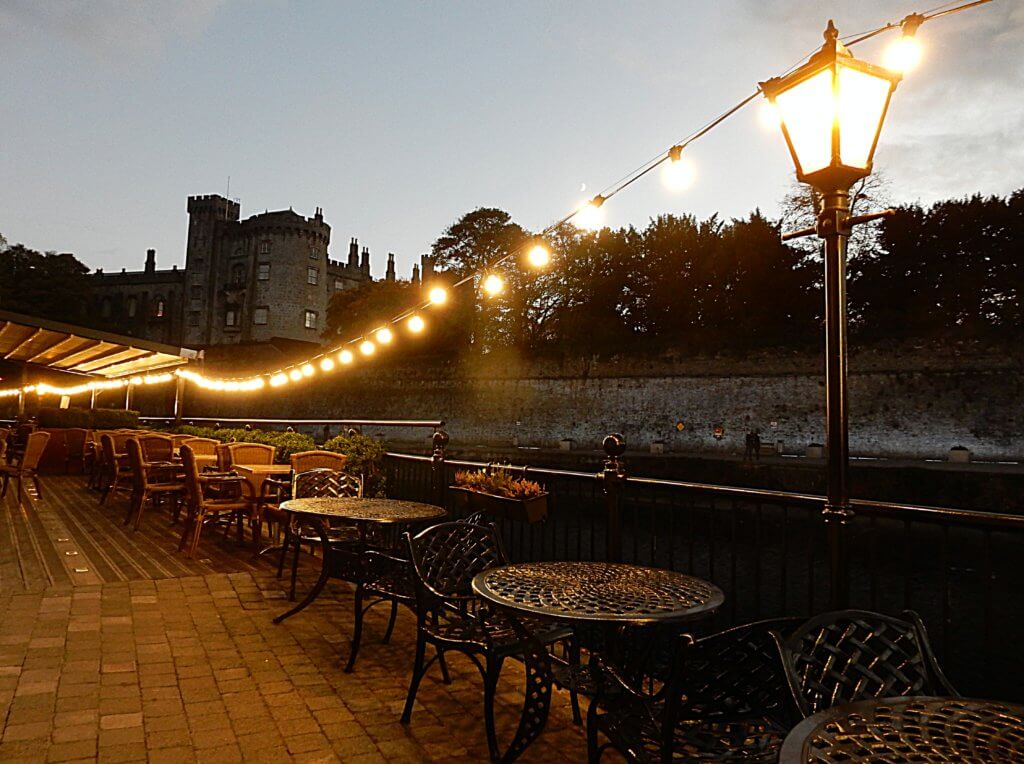
The 12th-century Kilkenny Castle from the porch of the Rivercourt Hotel. Photo/Linda Gasparello
Christmas is nearing in Ireland. The shops on Dublin’s O’Connell Street, the city’s main thoroughfare — and one of the widest in Europe — are brimming with decorations and merchandise. But even as the Irish start celebrating the holidays, they have not yet finished celebrating the centenary of the 1916 Easter Rising, which set Ireland on the path to its independence in 1922.
The holiday light vines on the lamp posts in front of the General Post Office on O’Connell Street illuminate banners that say, “Dublin Remembers 1916.” Walk down the street to Eason and you’ll see the bookstore’s front display tables laden with 1916-23 histories, from Fearghal McGarry’s “The Rising Ireland: Easter 1916 to Tim Pat Coogan’s “DeValera: Long Fellow, Long Shadow.”
Abeba, an Ethopian woman visiting Dublin, leafed through Sinead McCoole’s “Easter Widows: Seven Irish Women Who Lived in the Shadow of the 1916 Rising.” She told me, “ I took the 1916 bus tour. Now I want to read about women of the time.”
She had taken Dublin Bus’s “The 1916 Tour — Beyond Barricades,” in which on-board actors and film immerse passengers in the rebellion. “Dublin was in flames, and you really felt like you were there,” Abeba said.
The previous day, a bank holiday, my husband and I had taken the hop-on-hop-off bus tour. One loop included Kilmainham Jail, where the seven signatories to the declaration of The Provisional Government of the Irish Republic were executed from May 3-12, 1916.
Our driver told us that he had named his daughter Grace, after Grace Gifford, a gifted artist and cartoonist who was active in the Republican movement. Gifford married her fiance Joseph Mary Plunkett in the jail’s chapel only a few hours before he was executed for being a leader of the rebellion.
As we neared the jail, our driver sang a refrain from “Grace,” often sung by the late Jim McCann of The Dubliners folk band fame:
Oh, Grace just hold me in your arms, and let this moment linger,
They take me out at dawn and I will die.
With all my love I place this wedding ring upon your finger,
There won’t be time to share our love, so we must say good-bye.
Our driver told us that Kilmainham is a very busy site, and prebooking tickets is essential, especially during this centenary year. However, he said, there is easy access to the General Post Office on O’Connell Street, where our tour ended and where the Rising began.
“It came under heavy bombardment for a week. You can still see the bullet holes on the pillars and walls. Gutted by fire, it did not reopen until 1929,” he said.
The Rising began on April 24, 1916, and lasted six days. Early Easter Monday, 1,200 members of the Irish Volunteers and Irish Citizen Army, under the command of Patrick Pearse, a Gaelic scholar, schoolteacher and poet, and James Connolly, founder of the Irish Socialist Republican Party, with others seized the General Post Office on Sackville Street (now called O’Connell). On the building’s front steps, Pearse read the declaration, addressed to “The People of Ireland” and signed by himself, Connolly, Plunkett and four others.
Almost 500 people were killed in the Rising, more than half were civilians. More than 2,600 were wounded during heavy British machine-gun fire, shelling and fires that left parts of inner city Dublin in ruins.
Ireland got its independence from Britain in 1922, amid much strife and bloodshed. But the Irish state has retained close ties with Britain and is the only European Union country that it shares a border with.
It is sad and ironic that Ireland is not only celebrating the start of the British exit from their country in 1916, but it is also concerned about the start of the British exit from the EU – Brexit — next year.
Kilkenny’s ‘Medieval Mile’
If you’ve ever been daunted by a walking tour of a medieval European city, say Prague, then Kilkenny’s “Medieval Mile” will delight you.
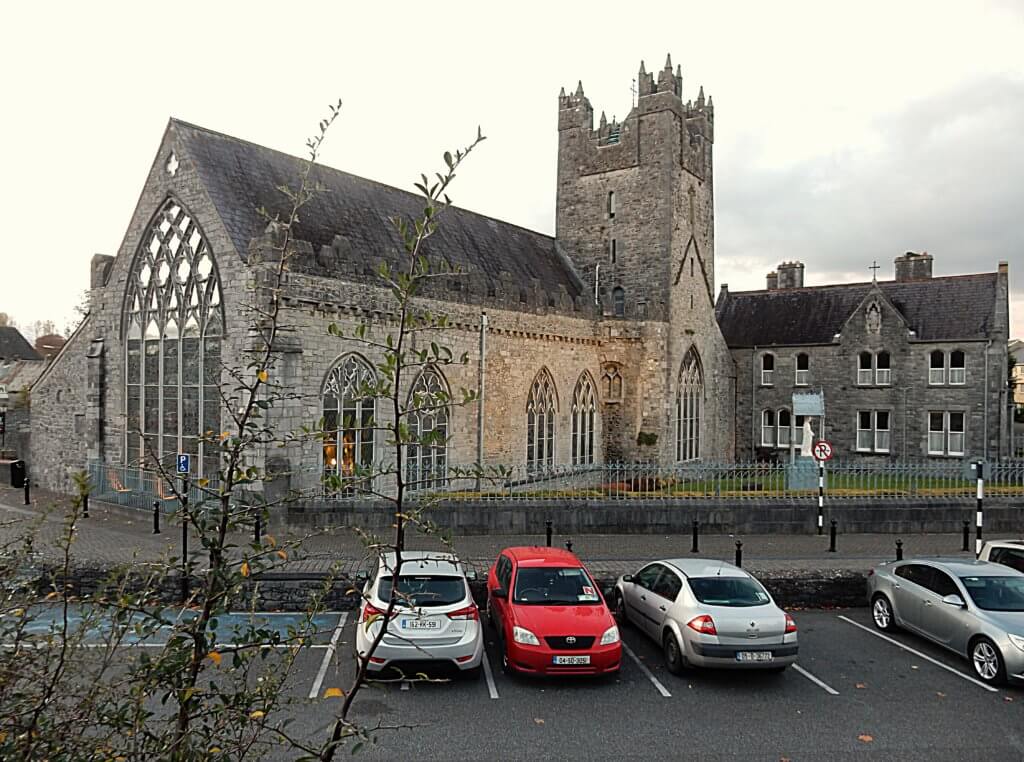
The Black Abbey, founded in 1225 and named after the Dominican order of monks, known for their black capes. Photo/Linda Gasparello
“Good goods sometimes come in small parcels,” Colette Byrne, CEO of the Kilkenny County Council, told the Association of European Journalists.
Just a mile-long, circular walk in Kilkenny (Ireland’s capital in the Middle Ages), Byrne said, will take you past a number of its marvels, including the 13th-century St. Mary’s Church, whose graveyard has a rare and significant collection of tombs, and The Black Abbey, founded in 1225 by William Marshall, Earl of Pembroke, for the Dominican order of monks, known for their black capes. The abbey is famous for its five-gabled, stained glass Rosary Window.
Along the mile, there are plenty of non-medieval buildings, notably the limestone Thosel Town Hall which dominates the High Street. Its name comes from two old English words “toll” meaning tax, and “sael” meaning hall. Built in 1761, it served as a custom house and guildhall – today, it’s where Kilkennians pay their taxes.
Across the street from the town hall, there is the Hole in the Wall: a tiny tavern in the inner house of a Tudor mansion built in 1582, and Ireland’s oldest surviving townhouse. Around 1660, in order to gain access from the High Street to the rear of the inner house, a hole was punctured in a wall.
“It was a favored haunt of Captain Arthur Wesley, who was stationed at Kilkenny barracks before being seconded to the British army in Spain and India, and eventually becoming the Duke of Wellington and British prime minister. Later it developed a reputation of ill renown due to duels, arguments, highwaymen, etc., and this led to its eventual demise,” a Hole in the Wall brochure says.
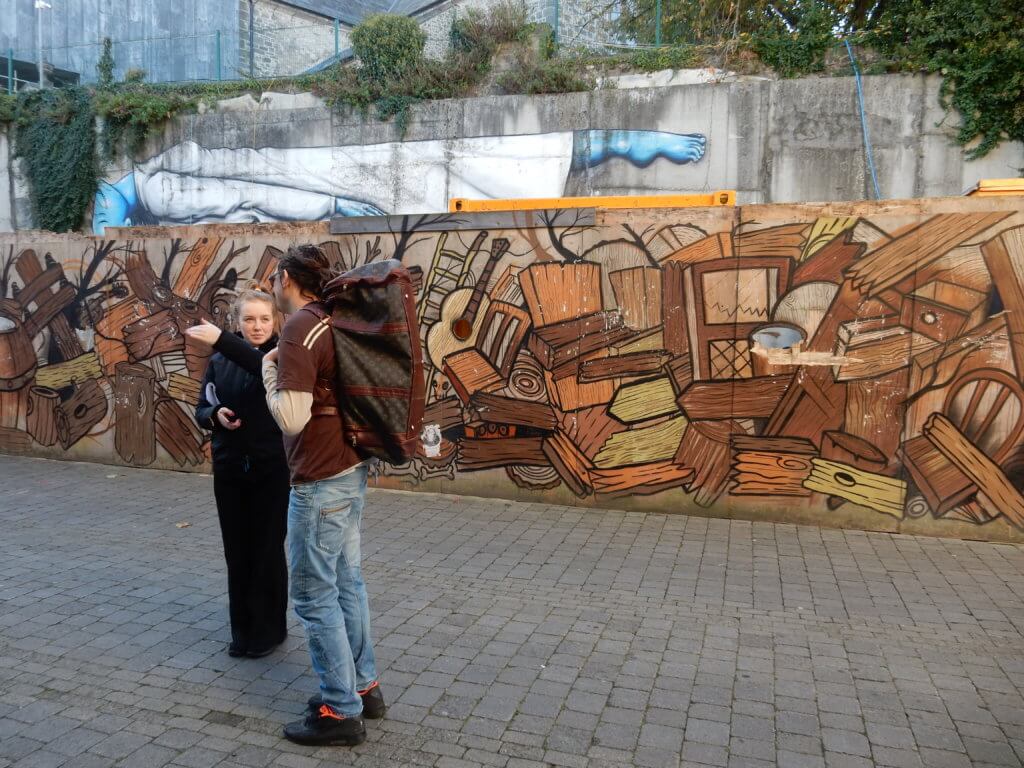
Standing in front of a pair of ghoulish murals, a visitor asks a local woman for directions to the High Street. Photo/Linda Gasparello
On St. Kiernan Street, behind the High Street on the circular walk, there is an inn with a notorious past: Kyteler’s. Ireland’s only witch trials took place in Kilkenny in 1324 – supposedly, they were Europe’s first witchcraft trials. Dame Alice Kyteler, an innkeeper and moneylender, was accused of using poison and sorcery against her four husbands, having amassed a fortune from them. Before she could be tried, Alice pulled strings and fled to England, but her maid was flogged and burned at the stake.
Down the street from Kyteler’s, there is long mural, commissioned by the Keep Kilkenny Beautiful Committee in 2013, with ghoulish images: ghosts, black cats with bared teeth, and a warning that “witches are amongst us.” Behind it, another is in the works: a blue-faced woman in a white dress, lying on her back, either asleep or dead. This mural seems to float above the one in front of it.
Kilkenny is a haven for muralists. Cast your eyes up on the High Street, and you’ll see a cheery pink wall of the Smithwick’s Brewery. Cast them down, on a corner of Friary Street, and you’ll see a black cat with a curled tail, waiting to cross your path.
On all our trips to Ireland over the years, Llewellyn and I don’t know how we missed this magical little city.
→ See more photos from Kilkenny in our photo gallery here.
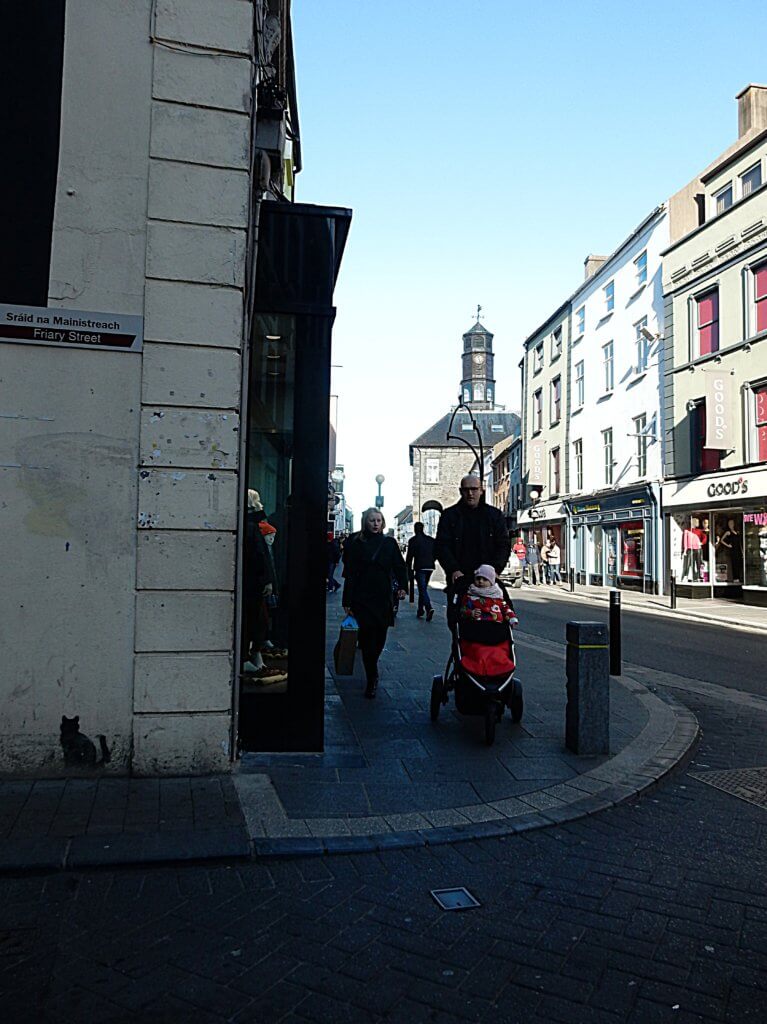
A man pushes a stroller down the High Street, as a painted black cat waits to cross their path on the corner. Photo/Linda Gasparello
